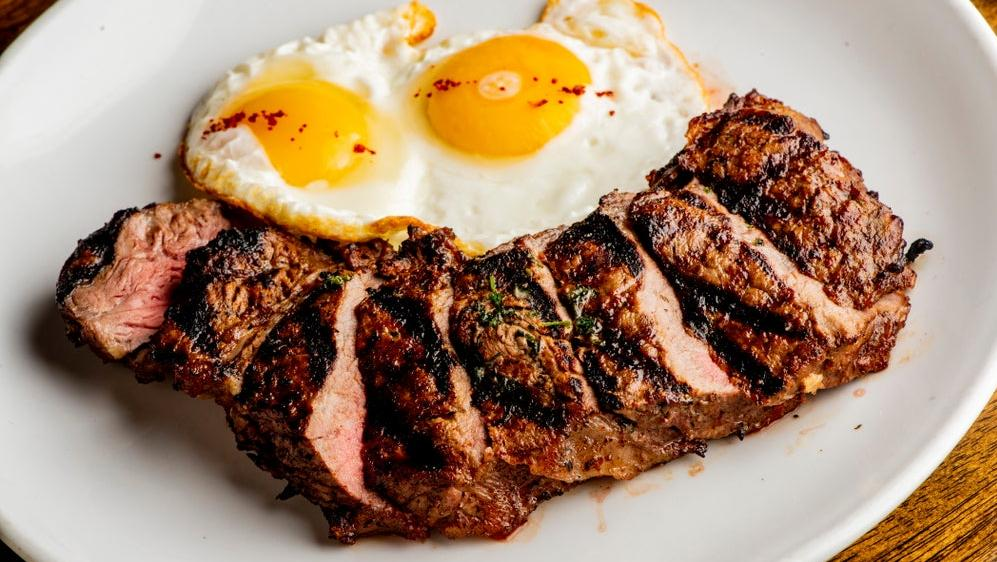Breakfast And Lunch Are Giving Dinner A Run For Its Money
Some of the fastest growing restaurant franchises stop serving before dark.
Dinner has traditionally been the main event in the restaurant world. Everyone gets gussied up, chefs spend hours creating the evening's menu, and servers score (hopefully) generous tips from wine-soaked customers. But in 2023, there's been something of a shakeup in the traditional order: Restaurants that don't serve dinner at all are stealing the spotlight from those that do.
Some of the hottest establishments right now are places that only sell breakfast and lunch, according to industry trade publication Restaurant Business. On this year's "Future 50" list, which tracks the fastest growing restaurant concepts in the United States, nine of the 50 chains are "midscale" or family dining concepts, including Breakfast Republic, Huckleberry's, and First Watch, each of which is growing like, well, hotcakes.
Of course, "daylight dining"—heading to a restaurant for breakfast or lunch rather than dinner—is an old-school idea. Cafes open only through midday have long been a mainstay of business districts, where activity dies down when commuters head home. But in the post-pandemic world, these spots are attracting customers who might once have saved their outings for the evening.
The impressive growth of First Watch
First Watch has been on an aggressive expansion drive lately, aiming to open as many as 2,200 U.S. restaurants, including 45 to 50 that will launch before the end of this year. The parent company, whose name comes from the nautical term for the first shift taken by each morning on a sailing ship, was founded 40 years ago by Ken Pendery and John Sullivan, who also started the Le Peep chain of breakfast restaurants. In 2014, they bought The Good Egg chain and subsequently purchased The Egg & I.
First Watch currently has nearly 500 locations in 29 states, 9,000 employees, and an enthusiastic following. I've dined in at the Novi, Michigan location with my brother Frank; the food was fine, and the extensive menu offers modifications to suit many food preferences. I found the vibe a little sterile, but with that many locations, you can't expect a personal touch.
Smaller daylight-focused chains are growing, too. Cafe Patachou in Indianapolis has seven locations. Grand Rapids, Michigan is home to Anna's House, a retro-style diner with 11 locations. Ruby Slipper, based in New Orleans, has 20 locations from North Carolina to Louisiana. And Big Bad Breakfast, founded in Oxford, Mississippi by chef John Currence, now has 18 locations across the South and three more in the works.
Why interest in breakfast and lunch is spiking
There are several factors that are fueling the daytime dining trend. Here are a few key reasons business is booming:
- Staffing. For owners, the more limited hours of a breakfast lunch spot help manage staffing. While the hiring crunch seems to be easing, a restaurant that's open from 6 a.m. to 2 p.m. one requires one full shift; some employees can even work a half shift and combine it with another job or be home when school lets out.
- Choices. Given how many people have different dining preferences, a breakfast and lunch place can satisfy a broad range of palates. Need a dish to be vegetarian? Leave off the meat. Carbo loading? Breakfast is a runner's dream. Vegan? Have a nice fruit bowl with a veggie hash. These meals are often basic, and that's their strength.
- Sober serving. While some spots have liquor licenses, the majority of these restaurants do not serve alcohol. That provides a family atmosphere and eliminates hassles for staff, as well as the owner's expense of getting a liquor license.
- Accommodation. Those of us who work remotely are always looking for places where we can dine and do business at the same time. One of my favorite respites when I lived in Phoenix was The Henry, the flagship restaurant of Fox Restaurant Concepts. While it features all-day dining, rather than just daylight, it attracts many customers who work on laptops throughout the day and host clients for meetings in its spacious lobby.
Daylight dining leaves room for smaller players
Because of all these factors, the breakfast/lunch field seems well-positioned to accommodate many types of players. Nick Panos, the owner of Nick's Original House of Pancakes in Ann Arbor, Michigan, tells me he's barely felt an impact from the new First Watch location that recently opened a few blocks away. Nick's, which has been in business since 2009, continues to draw crowds of diners who patiently wait half an hour or more on the weekend.
Given that demand, I asked Panos whether he might consider staying open longer each day and introducing dinner service.
"No," he replied. "I'd have to expand the menu, more staff and remarket it." To that end, Panos isn't surprised that daylight restaurants are growing in popularity. "Everyone is finding their niche—you can't be everything to everyone," he said.
The daylight trend is great news for places like bakeries and bagel shops, whose menus span the two meals nicely, and coffee houses whose menus include food are already ahead of the game as well. The success of these spots alongside the explosive growth of full-service chains like First Watch means the category has lots more room to grow.
With the days growing shorter, I can easily see breakfast and lunch places doing strong business in coming season. After all, in the cold winter months, most of us want to be snug as a bug at home by the time it's dark outside.
